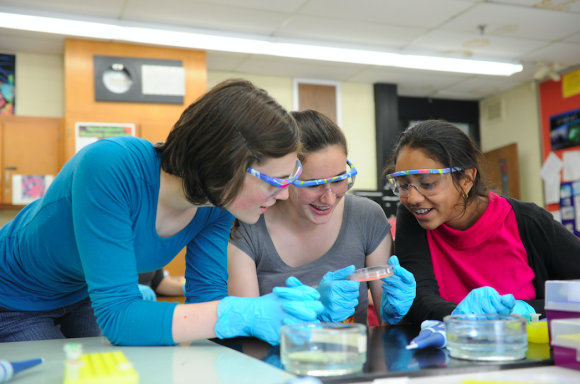The core of the Amgen Biotech Experience (ABE) is a unique partnership between scientists and teachers. Amgen scientists contribute their expertise in cutting-edge research and desire to empower students in STEM, while teachers contribute their expertise in how to interest and motivate students and their desire to connect STEM to the real-world.
“It’s a program neither of us could have done on our own,” says Annette Condon of the Amgen Foundation. “You hear so much about science education in abstract terms, so seeing educators and industry members talking about how they are working together is pretty powerful.” The strength of this industry-education partnership has enabled great growth and development for the biotech experience worldwide, but there is a demand for even more partnerships, Condon says.
At the ABE global annual meeting this past spring, the educators in attendance got to visit Ireland’s National Institute for Bioprocessing Research and Training and the local Amgen manufacturing site. But they expressed a great desire to connect even further with trends in the biotech industry in their local regions. And, Condon notes, many at the conference were not aware of the resources available to them to create new partnerships. “There’s a huge opportunity here,” Condon says, to expand the real-world context for the science being taught in the classroom and to strengthen community building.
Already, ABE sites are expanding the types of partnerships they have with their local communities. For example, in Australia, the local Amgen team sent all their staff into the classroom to observe the ABE program firsthand. In the United Kingdom, ABE welcomed policymakers into their classrooms, while in Ireland, Amgen staff have gone into local schools to talk about career opportunities.
These opportunities not only help to communicate the importance of science education to broader audiences, but they also set up new peer networks – connecting students and educators more deeply to their communities and helping local scientists strengthen their role as corporate citizens. “It’s about engaging teachers with one another and Amgen staff with their communities,” Condon says. “It’s a win-win for everyone involved.”
While the Amgen Foundation wants to encourage such partnerships, it also recognizes that the capacities for different sites to take on these initiatives varies greatly, Condon says. “It doesn’t have to be a big program overnight, it can start small,” she explains, and the local Amgen sites have a lot of resources to help. Developing local milestones, she says, such as teacher appreciation events or a policymaker visiting the classroom, can also help local sites meet their individual community-building goals.
While ABE is an international program to educate and empower young people in biotechnology, the program is ultimately locally run with each site in a unique sociopolitical setting and with distinct needs. “We believe that the more the program can be relevant to local situations and can connect students to the real world, the more powerful the experience for students and educators alike,” Condon says.
Speaking to a captive audience of educators at the global meeting in Dublin, Condon summed up ABE’s collaborative strategy: “Collaboration is at the very heart of this program. Our scientists are at the cutting-edge of research. They have access to the latest data, the breakthrough research, the trends. You are the educators. You understand the national curriculum, what excites students, how to explain concepts, how to manage a classroom and assess students’ performance. We are both passionate about science. Together, we combine our expertise to make a difference.”
